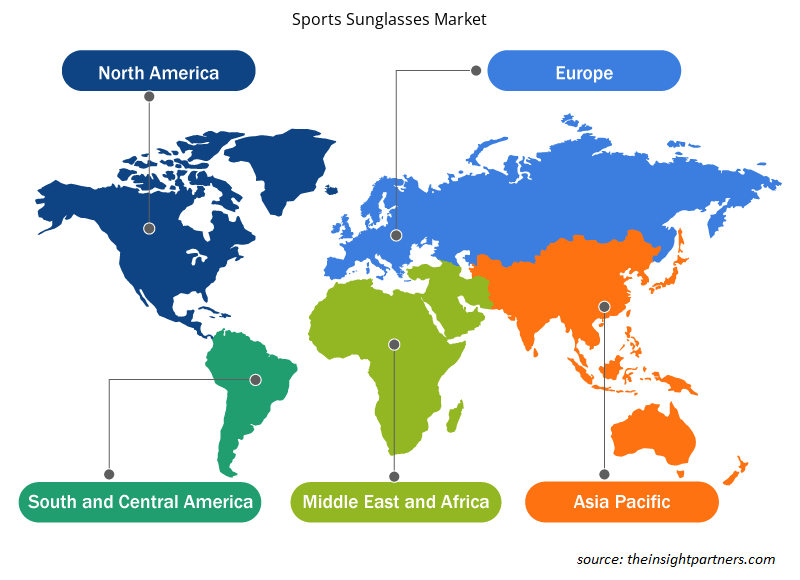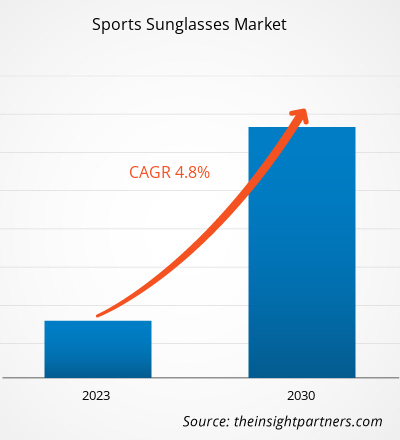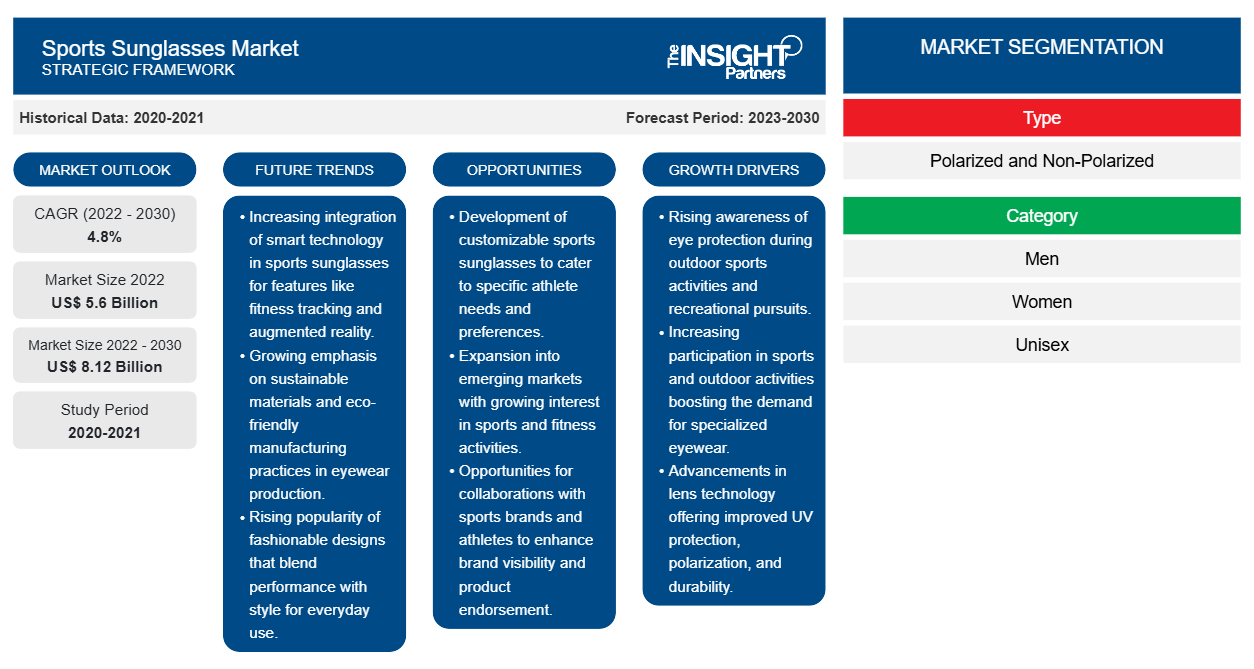[Forschungsbericht] Der Markt für Sport-Sonnenbrillen soll von 5.597,08 Millionen US-Dollar im Jahr 2022 auf 8.115,06 Millionen US-Dollar im Jahr 2030 wachsen; der Markt soll von 2022 bis 2030 eine durchschnittliche jährliche Wachstumsrate (CAGR) von 4,8 % verzeichnen.
Markteinblicke und Analystenansichten:
Sport-Sonnenbrillen sind Schutzbrillen, die zur Verbesserung der Sicht und des Komforts bei Outdoor-Sportarten verwendet werden. Sie minimieren die Einwirkung von grellem Sonnenlicht, um Augenschäden vorzubeugen. Die Linsen werden aus Kunststoff oder Glas hergestellt. Sie sind mit UV-Blockern und schlagfesten Filmen beschichtet, die Blendung reduzieren und den Kontrast verbessern, um eine bessere Sicht auf dem Feld zu gewährleisten. Die Sonnenbrillen sind auch in polarisierten oder nicht polarisierten Ausführungen mit getönten und nicht getönten Gläsern erhältlich, wodurch sie für den Alltag geeignet sind. Sport-Sonnenbrillen werden im Allgemeinen bei sportlichen Aktivitäten wie Radfahren, Schwimmen, Mountainbiken, Radfahren, Baseball, Cricket und anderen Outdoor-Aktivitäten getragen. Diese Faktoren treiben den Markt für Sport-Sonnenbrillen an
Wachstumstreiber und Herausforderungen:
Viele Menschen betreiben verschiedene Sportarten und Outdoor-Aktivitäten. Sportbegeisterte wissen, wie wichtig es ist, ihre Augen vor potenziellen Risiken wie Staub, Wind und Schmutz zu schützen. Daher verwenden sie Sportsonnenbrillen, die optimalen Schutz bieten und die Leistung bei sportlichen Aktivitäten verbessern. Laut der Sports & Fitness Industry Association (SFIA) nahmen im Jahr 2022 mehr als 76 % der Bevölkerung (d. h. 236,9 Millionen Menschen) in den USA an mindestens einer Aktivität teil, was einem Anstieg der Gesamtbeteiligungsquote um 9,2 % gegenüber 2017 und um 1,9 % gegenüber 2021 entspricht. Laut Eurostat trieben im Jahr 2019 rund 44 % der europäischen Bevölkerung mindestens einmal pro Woche irgendeine körperliche Aktivität aus. Darüber hinaus hat ein vielfältiges Angebot an Sportarten und Outdoor-Aktivitäten eine Nachfrage nach Sportsonnenbrillen geschaffen, die auf spezifische Bedürfnisse zugeschnitten sind.
Darüber hinaus hat der kulturelle Wandel hin zu einem gesünderen und aktiveren Lebensstil die Zahl der Menschen erhöht, die Sport treiben und Outdoor-Aktivitäten nachgehen. Dieser Wandel beschränkt sich nicht nur auf Leistungssportler, sondern umfasst auch Personen, die Freizeitsport betreiben, laufen, wandern und andere Freizeitaktivitäten ausüben. Sport-Sonnenbrillen sind zu einem modischen Statement und einem Symbol dieses aktiven Lebensstils geworden.
Längere Einwirkung von ultravioletter (UV-)Strahlung, insbesondere im Freien, kann zu verschiedenen Augenbeschwerden und -krankheiten wie Katarakt, Photokeratitis und Pterygium führen. Diese Beschwerden können zu Unbehagen, Sehbehinderung und in einigen Fällen zu dauerhaften Augenschäden führen. Beim Sport oder anderen Outdoor-Aktivitäten benötigen Personen klares und ungestörtes Sehen, um Höchstleistungen erbringen zu können. Übermäßige Einwirkung von UV-Strahlen kann zu Schielen, Unbehagen und verminderter Sehschärfe führen. Sport-Sonnenbrillen mit UV-Schutz sorgen dafür, dass Sportler während ihrer Aktivitäten optimale Sicht und Konzentration bewahren und so ihre Gesamtleistung steigern können.
Passen Sie diesen Bericht Ihren Anforderungen an
Sie erhalten kostenlose Anpassungen an jedem Bericht, einschließlich Teilen dieses Berichts oder einer Analyse auf Länderebene, eines Excel-Datenpakets sowie tolle Angebote und Rabatte für Start-ups und Universitäten.
-
Holen Sie sich die wichtigsten Markttrends aus diesem Bericht.Dieses KOSTENLOSE Beispiel umfasst eine Datenanalyse von Markttrends bis hin zu Schätzungen und Prognosen.
Berichtssegmentierung und -umfang:
Der „globale Markt für Sport-Sonnenbrillen“ ist nach Typ, Kategorie, Vertriebskanal und Geografie segmentiert. Nach Typ ist der Markt für Sport-Sonnenbrillen in polarisierte und nicht polarisierte unterteilt. Nach Kategorie ist der Markt in Männer, Frauen, Unisex und Kinder segmentiert. Nach Vertriebskanal ist der Markt für Sport-Sonnenbrillen in Supermärkte und Hypermärkte, Fachgeschäfte, Online-Einzelhandel und andere segmentiert. Nach Geografie ist der Markt in Nordamerika (USA, Kanada und Mexiko), Europa (Deutschland, Frankreich, Italien, Großbritannien, Russland und der Rest von Europa), Asien-Pazifik (Australien, China, Japan, Indien, Südkorea und der Rest von Asien-Pazifik), den Nahen Osten und Afrika (Südafrika, Saudi-Arabien, die Vereinigten Arabischen Emirate und der Rest von Nahem Osten und Afrika) und Süd- und Mittelamerika (Brasilien, Argentinien und der Rest von Süd- und Mittelamerika) segmentiert.
Segmentanalyse:
Der Markt für Sport-Sonnenbrillen ist nach Typ in polarisierte und nicht polarisierte unterteilt. Das nicht polarisierte Segment hatte 2022 einen erheblichen Marktanteil. Die Nachfrage nach nicht polarisierten Sport-Sonnenbrillen steigt bei Sportlern und Fitnessbegeisterten, die ihre Augen während der Leistung schützen und gleichzeitig für ihr allgemeines Wohlbefinden sorgen müssen. Fortschritte in der Linsentechnologie haben zur Einführung leichterer, bequemerer und langlebigerer nicht polarisierter Sport-Sonnenbrillen geführt, die ein breiteres Publikum ansprechen. Darüber hinaus hat der Einfluss der Modebranche auf Sportaccessoires zur Popularität stylischer und funktionaler nicht polarisierter Sport-Sonnenbrillen bei Menschen beigetragen, die bei der Wahl ihrer Brille auf Leistung und Ästhetik achten.
Regionale Analyse:
Geografisch ist der Markt für Sport-Sonnenbrillen in fünf Hauptregionen unterteilt: Nordamerika, Europa, Asien-Pazifik, Süd- und Mittelamerika sowie Naher Osten und Afrika. Nordamerika dominierte den globalen Markt für Sport-Sonnenbrillen. Der regionale Markt wurde im Jahr 2022 auf 1.791 Millionen US-Dollar geschätzt. Europa ist der zweitgrößte Marktteilnehmer und hält fast 25 % des Weltmarkts. Der Nahe Osten und Afrika werden im Prognosezeitraum voraussichtlich eine durchschnittliche jährliche Wachstumsrate (CAGR) von 6,5 % auf dem Markt für Sport-Sonnenbrillen verzeichnen. In Nordamerika wird der Markt voraussichtlich aufgrund der steigenden Teilnahme am Sport und des zunehmenden Bewusstseins für Augenschutz deutlich wachsen. Laut der Sports & Fitness Industry Association (SFIA) nahmen im Jahr 2022 mehr als 76 % aller Amerikaner oder 236,9 Millionen Menschen an mindestens einer Sportaktivität teil. Daher treibt die zunehmende Teilnahme der Nordamerikaner an verschiedenen Sportkategorien die Nachfrage nach Sport-Sonnenbrillen in der gesamten Region weiter an. Darüber hinaus hat der Markt im Nahen Osten und in Afrika aufgrund umfangreicher staatlicher Investitionen in den Sportsektor ein deutliches Wachstum verzeichnet. So gaben die Mitgliedsstaaten des Golfkooperationsrates (GCC), darunter Saudi-Arabien und die Vereinigten Arabischen Emirate, im Jahr 2022 über 65 Milliarden US-Dollar für die Entwicklung des Sports aus, wobei der Schwerpunkt auf Fußball und E-Sport lag, denen das größte Umsatzwachstumspotenzial zugeschrieben wird. Das zunehmende Bewusstsein für die Bedeutung von Sport und körperlicher Fitness bei Einzelpersonen und Fitnessbegeisterten treibt die Nachfrage nach Sport-Sonnenbrillen im Nahen Osten und in Afrika an.
Branchenentwicklungen und zukünftige Chancen:
Nachfolgend sind verschiedene Initiativen wichtiger Akteure auf dem Markt für Sport-Sonnenbrillen aufgeführt:
- Im Dezember 2022 arbeitete SunGod, eine britische Brillenmarke, mit einem in London ansässigen Radrennteam zusammen, um Tekkerz Vulcanz, die Vulcanz-Sonnenbrille, auf den Markt zu bringen. Das Modell verfügt über eine photochrome Linse, einen Rahmen aus UV-Licht-Memory-Polymer sowie hydrophile Ohrpolster und Nasenpads.
Regionale Einblicke in den Markt für Sport-Sonnenbrillen
Die regionalen Trends und Faktoren, die den Markt für Sport-Sonnenbrillen im Prognosezeitraum beeinflussen, wurden von den Analysten von Insight Partners ausführlich erläutert. In diesem Abschnitt werden auch die Marktsegmente und die Geografie für Sport-Sonnenbrillen in Nordamerika, Europa, im asiatisch-pazifischen Raum, im Nahen Osten und Afrika sowie in Süd- und Mittelamerika erörtert.

- Erhalten Sie regionale Daten zum Markt für Sport-Sonnenbrillen
Umfang des Marktberichts für Sport-Sonnenbrillen
| Berichtsattribut | Details |
|---|---|
| Marktgröße im Jahr 2022 | 5,6 Milliarden US-Dollar |
| Marktgröße bis 2030 | 8,12 Milliarden US-Dollar |
| Globale CAGR (2022 - 2030) | 4,8 % |
| Historische Daten | 2020-2021 |
| Prognosezeitraum | 2023–2030 |
| Abgedeckte Segmente |
Nach Typ
|
| Abgedeckte Regionen und Länder |
Nordamerika
|
| Marktführer und wichtige Unternehmensprofile |
|
Dichte der Marktteilnehmer für Sport-Sonnenbrillen: Die Auswirkungen auf die Geschäftsdynamik verstehen
Der Markt für Sport-Sonnenbrillen wächst rasant, angetrieben von der steigenden Nachfrage der Endnutzer aufgrund von Faktoren wie sich entwickelnden Verbraucherpräferenzen, technologischen Fortschritten und einem größeren Bewusstsein für die Vorteile des Produkts. Mit steigender Nachfrage erweitern Unternehmen ihr Angebot, entwickeln Innovationen, um die Bedürfnisse der Verbraucher zu erfüllen, und nutzen neue Trends, was das Marktwachstum weiter ankurbelt.
Die Marktteilnehmerdichte bezieht sich auf die Verteilung von Firmen oder Unternehmen, die in einem bestimmten Markt oder einer bestimmten Branche tätig sind. Sie gibt an, wie viele Wettbewerber (Marktteilnehmer) in einem bestimmten Marktraum im Verhältnis zu seiner Größe oder seinem gesamten Marktwert präsent sind.
Die wichtigsten auf dem Markt für Sport-Sonnenbrillen tätigen Unternehmen sind:
- Zehnkampf
- Adidas AG
- Luxottica-Gruppe
- Liberty Sport
- Nike Inc
Haftungsausschluss : Die oben aufgeführten Unternehmen sind nicht in einer bestimmten Reihenfolge aufgeführt.

- Überblick über die wichtigsten Akteure auf dem Markt für Sport-Sonnenbrillen
Auswirkungen der COVID-19-Pandemie:
Die COVID-19-Pandemie wirkte sich negativ auf nahezu alle Branchen in zahlreichen Ländern aus. Lockdowns, Reisebeschränkungen und Betriebsschließungen in Nordamerika, Europa, im asiatisch-pazifischen Raum (APAC), in Süd- und Mittelamerika sowie im Nahen Osten und Afrika (MEA) behinderten das Wachstum mehrerer Branchen, darunter auch der Konsumgüterindustrie. Die Schließung von Produktionseinheiten störte die globalen Lieferketten, Fertigungsaktivitäten, Lieferpläne sowie den Verkauf lebensnotwendiger und nicht lebensnotwendiger Produkte. Verschiedene Unternehmen meldeten Verzögerungen bei Produktlieferungen und einen Einbruch ihrer Produktverkäufe im Jahr 2020. Außerdem waren die Hersteller in der Anfangsphase der Krise stark von den vorhandenen Lagerbeständen abhängig. Aufgrund der pandemiebedingten Wirtschaftsrezession wurden die Verbraucher bei ihren Kaufentscheidungen vorsichtiger und selektiver. Sie schränkten nicht lebensnotwendige Einkäufe aufgrund niedrigerer Einkommen und unsicherer Verdienstaussichten, insbesondere in Entwicklungsregionen, erheblich ein.
Bis Ende 2021 waren viele Länder vollständig geimpft und die Regierungen kündigten Lockerungen bestimmter Vorschriften an, darunter Ausgangssperren und Reiseverbote. Veränderte Lifestyle-Trends nach der Pandemie, wie etwa eine zunehmende Betonung von Komfort, Bequemlichkeit und Personalisierung, beeinflussten die Nachfrage nach Sport-Sonnenbrillen. Das Wachstum des Online-Einzelhandels während der Pandemie bot auch Chancen für Hersteller von Sport-Sonnenbrillen. Darüber hinaus erleichterte die Lockerung der Handelsbeschränkungen den Import- und Exportbetrieb und wirkte sich positiv auf das Wachstum des Marktes für Sport-Sonnenbrillen aus.
Wettbewerbslandschaft und Schlüsselunternehmen:
Columbia Sportswear Co, EssilorLuxottica SA, Liberty Sport Inc, Under Armour Inc, Nike Inc, Rapha Racing Ltd, Puma SE, Decathlon SE, Adidas AG und Safilo Group SpA gehören zu den führenden Akteuren auf dem globalen Markt für Sport-Sonnenbrillen. Diese Marktteilnehmer ergreifen strategische Entwicklungsinitiativen, um zu expandieren und das Marktwachstum weiter voranzutreiben.
- Historische Analyse (2 Jahre), Basisjahr, Prognose (7 Jahre) mit CAGR
- PEST- und SWOT-Analyse
- Marktgröße Wert/Volumen – Global, Regional, Land
- Branchen- und Wettbewerbslandschaft
- Excel-Datensatz
Aktuelle Berichte
Erfahrungsberichte
Grund zum Kauf
- Fundierte Entscheidungsfindung
- Marktdynamik verstehen
- Wettbewerbsanalyse
- Kundeneinblicke
- Marktprognosen
- Risikominimierung
- Strategische Planung
- Investitionsbegründung
- Identifizierung neuer Märkte
- Verbesserung von Marketingstrategien
- Steigerung der Betriebseffizienz
- Anpassung an regulatorische Trends























 Kostenlose Probe anfordern für - Markt für Sport-Sonnenbrillen
Kostenlose Probe anfordern für - Markt für Sport-Sonnenbrillen